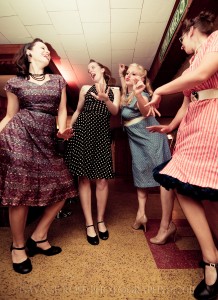by Lauren Warnecke

Perhaps one of the biggest barriers that “normal people” express about going to see modern dance is that they don’t understand it. At nearly every post-show talk-back I’ve ever attended there are at least one or two people who start their comment with, “Now, I don’t know anything about modern dance, but…..” yada yada, you fill in the blank. The standard issue response that I tend to hear is “you don’t have to understand it,” or “whatever you FEEL it’s about, IS what it’s about.”
That is completely true, and something I’ve said myself on numerous occasions. But over the past few months I’ve been formulating a theory that it’s not a particularly useful response. In other words, I’m thinking that “come to this weird thing you don’t have to understand” isn’t as effective a tagline as we’d like to think it is to getting butts in seats. After all, we are all human. We crave compelling stories and generally tend to try to apply meaning to things. Dance, however, often lives in a world of abstraction where the layers of meaning are imbedded in movements and gestures that don’t obviously reveal their stories. That’s what program notes are for…
The problem is, sometimes we (the choreographers) are so lost in the tangled web of ideas and abstraction that we too can’t exactly articulate what our pieces are about. When I gaze into a set of program notes and read that the dance I’m about to see is about a girl’s fiancé breaking their engagement, or satanic cults, or gender identity, I get a little overwhelmed.* Seeing a dance concert should be a relaxing and enjoyable experience that is accessible to everyone, and satanic cults are something I don’t often feel like dealing with on a Friday night. It’s not that these topics aren’t important and can’t or shouldn’t be explored through dance; it’s just that maybe you can find another way to express your idea by pairing it with something a little easier to swallow. Either way, heavy topics often become so abstracted by the time they reach the stage that you might as well say that the piece is about puppies, because the untrained eye won’t really see the difference anyway. No matter the subject, we come up with quips and phrases for press releases and program notes that say sort of what we think our piece is about, but most program notes could really just say “this piece is about whatever you feel it’s about and you don’t have to understand it” (read: “I’m not so sure what it’s about either…”).
In the end, my advice to new dancemakers is to keep it simple. I’m not suggesting that you have to cater to uninformed audiences or pursue a dance about puppies if that’s not what you’re interested in; I’m simply suggesting that we don’t ostracize potential audience members by taking on bigger ideas than necessary. Sometimes the simplest ideas are the most potent, because giving them due diligence in your exploration often renders far more complexity than you originally anticipated. In other words, simple deas can be complicated too.
In my own work, I’m on a kick with 50’s housewives.** Admittedly it’s gotten a little out of control. I’ve spend hours scouring pinterest for rockabillies and vintage pin-ups. The more I shop at vintage resale shops, buy pettipants from ebay, and cook from my first edition (reprint) Betty Crocker cookbook, the more inspired I get. To be honest, I’m so enamored by housewives that I don’t know where my next dance comes from. But that’s ok. I’ve decided that it’s not a bad thing to make, re-make, and re-remake a dance based on the same idea, because it only gains richness, depth, and meaning in the process. Circling back to my point about satanic cults and puppies, my piece appears outwardly like a fun little ditty about housewives, but also references issues of success and self-actualization that are deep, involved and personal. That’s something that can be enjoyed whether you understand the inner workings of my brain or not.
At the end of the day, we (that is, contemporary dancemakers) can make art for art’s sake all day long, but we need our audience in order to survive, and that audience craves meaning in the things we create. You need to know what your piece is about if you want your audience to know what it’s about, and your audience needs to know what your piece is about in order to get their non-dance friends to come see you too.
* Not an exaggeration; I’ve seen program notes detailing all three of these subjects.
** For those of you in the Chicago area, see the housewives in action this weekend at The Drucker Center. For tickets and more info visit: http://fanfueled.com/Venue/Details/509-fasseas-whitebox-theater

Contributor Lauren Warnecke is a Chicago-based dance artist, educator and writer. She trained at Judith Svalander School of Ballet and Barat Conservatory of Dance before earning a BA in Dance at Columbia College Chicago. In 2009, Lauren completed her MS in Kinesiology at the University of Illinois at Chicago. She is an adjunct instructor for the Department of Kinesiology at UIC, the Performing Arts Coordinator at the Menomonee Club for Boys and Girls, a member of the Cecchetti Council of America, and Neurotransmitter to Synapse Arts Collective (read: too many jobs).
Lauren created and maintains Art Intercepts as a platform for dance that is informed, inventive, and evidence-based. In addition to writing at 4dancers, Lauren is a columnist at Dance Advantage, specializing in dance injuries and prevention, dancer wellness, and evidence-based teaching practices. She also enjoys her freelance work as a grant writer and production manager and likes to grow strawberries, bake scones, and dig in the dirt.





I was so happy that Lauren wrote this because it is something I struggle with. I have such a hard time with Modern dance and a lot of what she pointed out in this post resonates with me. I’m anxious to hear other audience members and Modern dancers ring in with their thoughts too….what do you think?